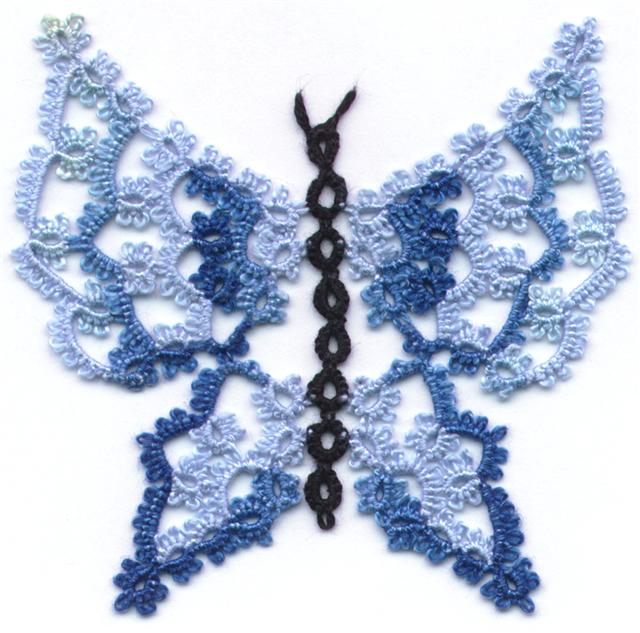No, you wouldn't. Well you ought to. And why would you want to tie itty bitty knots? To make stamens of course. I'm tired of cold and snow so I was thinking spring. Does this say spring to you? It does to me.
3D tatting can be challenging, but you just have to take it one step at a time. Beginning with these frustrating knots I started with a central ring in yellow of 2-2-2-2-2-2, but that left things empty in the middle. Then I tried alternate small picots and large picots with a stitch count of 1 between. Bend those ridiculous stamens out of the way tat the split ring and carry on joining into the small picots. Stretched out I allowed about 1.5 inches for the long picots. Just enough so that I could tie a knot in the tip of the picot. You want to keep all the long picots about the same size. See what the first round looks like - alien antennae.
Take note of the little stars shown on the first row. More about them later.
The large rings on row 2 are 4-4-4-4 and I made the side picots a little bit longer than usual so that the trumpet part of the flower would have a bit more flare. You'll notice that although the pattern shows this row as being outside the first row, the tatting is actually perpendicular to it. At this point you may want to pull on the tatting and stretch it into shape. It should kind of look like a thimble. Here it is completed.
Change to white thread and join to row 1 of the yellow trumpet where marked with stars. You'll actually be joining to the picots on the bit with the antennae. There's already a row 2 of the yellow trumpet in these joins at the tip of the picot, so you have to make the white join into the picot beside the yellow. You can join to the left or the right of the yellow join, but be consistent. Once you have the first row of white done you can start to see the flower taking shape.
Blocking 3D objects can be problematic which is why I don't usually bother with blocking it. I pull the lace into shape tugging and stretching the lace. On this design, you could block the white part of the lace, but on the yellow part you'll have to be content with finger blocking. Finish it off by grasping all of those tiny knots and pulling them up to sit neat and pretty in the middle of the flower. The finished flower is about 2.5 inches from point to point done in size 20 thread. These samples were done in Lizbeth Lemon Yellow and White.
I guess you need a pattern to do that don't you? Row 2 shows a dashed line connecting the side picots of the rings. The picots are obviously not as long as that. Row 2 is vertical and to show it from the
top all you'd get on the visual is a straight line. Showing it flattened out makes for those longer lines.
You'll note that on the rest of the diagram row 2 is omitted because you join into row 1 and continue on from there. I probably should have taken a picture after the first row of white was done, but I didn't think of it.
I tatted the first one using twisted picots and tiny outward facing rings on each petal. I did the second one with teeny tiny knots on the stamens and omitted the outer ring on each petal. I think I prefer it with the outer rings and that's the way it's drawn, but you can use them or omit them, whichever way you like it.
For those of you thinking I'd go for a spate of tatted eggs, sorry to disappoint, I'm more in the mood for flowers.








5 comments:
Perfect for Spring!
It turned out fine 🌼🌼🌼
But I'll need to read again to understand the details 😄
Those are one of my favorite flowers love this thanks for sharing pattern 🌿🌼🌿
Beautiful! I love flowers (and butterflies!).
I need to come back and reread this, I did design a daffodil Ice Drop,
Hope to see more flowers
Post a Comment